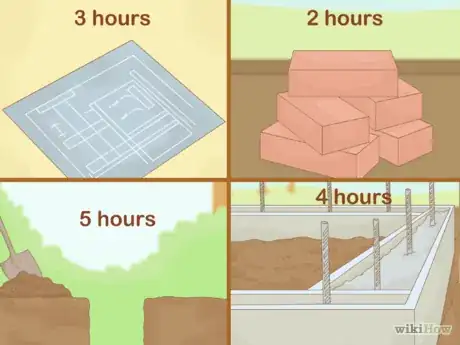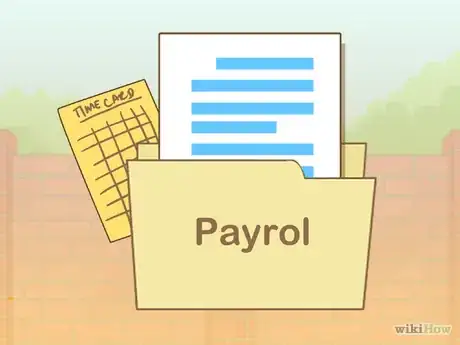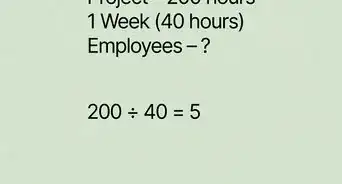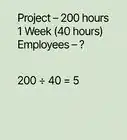This article was co-authored by Michael R. Lewis. Michael R. Lewis is a retired corporate executive, entrepreneur, and investment advisor in Texas. He has over 40 years of experience in business and finance, including as a Vice President for Blue Cross Blue Shield of Texas. He has a BBA in Industrial Management from the University of Texas at Austin.
wikiHow marks an article as reader-approved once it receives enough positive feedback. In this case, several readers have written to tell us that this article was helpful to them, earning it our reader-approved status.
This article has been viewed 356,326 times.
Man-hours are a crucial element in submitting a winning project bid as well as charging for work completed. Because labor constitutes such a large portion of any contract work, estimating and reporting hours accurately is crucial to having a successful business.
Steps
Estimating Man-Hours for a Project Bid
-
1Divide your project into components. The first part of calculating the man-hours you will need to do a job is to split up the project into smaller components. Then estimate the amount of hours needed to complete each component. These components should be designated according to the type of labor involved. If you are building an apartment complex, you will need excavation, construction, electrical, plumbing, and so on. Make sure that every component of your project is included in the estimate.
-
2Determine the type of workers you need. This largely depends on the complexity of the tasks that need to be accomplished. You don’t need a foreman to do every job. Some simpler tasks can be done by assistants or apprentices. Figuring this out is harder for larger jobs that require a mix of labor to do tasks that range from simple to complex.[1]Advertisement
-
3Estimate the time needed to complete each component. Once you have determined your components and the types of labor each requires, estimate the total number of man-hours it would take your workers to complete a step from start to finish. Do not include breaks. This number should be the hours of dedicated labor it will take to finish a step.
- If you are familiar with the type of work required in a step, you can draw from past projects to get time estimates. For example, if you know it took one worker ten hours to install four new windows, or 2.5 hours per window, your current project will likely be similar.
- If a step in your project includes a type of labor you're not familiar with, you should do some research in preparing your estimate. Depending on the project, you may be able to get valuable information online or from another contractor. You can also hire a consultant familiar with the type of labor you need. This person can help you estimate the hours required in a certain step.
- Factor in things like job difficulty when making your estimate. If the windows on your upcoming project are on the seventh story of a building, and your old project's windows were on the first story, increase your hours-per-window rate to reflect this difference.
- Include estimates for time spent on administrative tasks that may be required by the contract.
-
4Include hours for supervisors. You may also include project hours for a foreman or manager, who will lead the team of workers and manage reporting details and timeline compliance. Some projects may require more than one supervisor or foreman, managing different components of the project. Other projects may require different levels of supervision. You may have foreman managing workers in different components of the project and an overall supervisor who manages all of the foremen.
-
5Use your estimates to prepare a project timeline. Your client will likely specify a time for completion of the project. Perhaps he will ask you to indicate in your bid how soon you can complete your work. You can use the steps and hours you have calculated to develop a project timeline. Determine which components can be completed simultaneously and which must be completed sequentially, where the input of one process depends upon the output of the previous process. If you know when each step of the project needs to be completed, you can divide the number of hours needed to complete a step by the number of eight-hour workdays in the time period. You may be able to extend or shorten the project timeline by adding or removing laborers. The more laborers you have, the faster you can complete a step.
- Some projects may require more than 8 hour days or 40 hours week to meet schedule. They will require overtime which should be charged to the job
- For example, if you have one month to lay the foundation of a new home, and you know the foundation requires 1000 hours of labor, divide 1000 by the number of eight-hour workdays in the month to calculate the number of laborers you need to hire to complete that step on time. (1000 project hours / 20 work days in the month = 50 hours per day; 50 hours per day / 8 hours per worker = 6.25 laborers needed.)[2] Round the number of laborers up or down to a whole number, and adjust accordingly the number of workdays required.
- Be realistic about the number of workers you can hire in a given time period. If you need seven electricians to complete wiring in a week, this may be unrealistic, depending on the availability of electricians in your area. You may need to extend your timeline to accommodate the availability of labor for your project.
- If you plan to complete multiple steps at the same time, you'll need separate laborers to work on each step.
-
6Prepare and submit your bid. Add the hours for each type of labor you need, so you have a total for each type. If you require just one type of labor, you can combine all of the project hours into one number. If you need multiple types of labor, your bid should specify the total hours for each type. You should include all labor costs including taxes and benefits. Some Federal contracts may require a minimum wage for each category of workers. Also, include any markup you plan to charge.
- As an example, imagine you have been hired to install a new kitchen in a medium-sized home. You have divided your project into steps, each requiring plumbing, electrical, and general construction work. Your bid should reflect the total electrician man-hours, plumber man-hours, and general-laborer man-hours, as well as the pay rates for each type of labor.
-
7Adjust your man-hour estimates as the work progresses. Because time estimates are really just guesses, you will need to update your estimates as your project goes along. You will probably bill your client based on the actual hours your team works, so you should provide your client updated hourly estimates as time passes. This helps prevent surprises for your client when billing time rolls around.
- Include a "fudge factor," which is an increase in estimated time due to unknown causes. The amount of fudge factor depends upon the complexity of the job, availability of labor, dependence upon outside agents, and the relationship of one process to another.
- Most contractors make it clear that their bid is only an estimate, that actual hours will vary, and that clients will pay for actual hours worked as the job progresses. However, it is possible a client will want to pay you a lump sum based on your estimate and not pay for actual hours worked. Pay close attention to any contract language that would signal this kind of arrangement, as this requires very careful estimation on the part of the contractor.
- If your client will pay you based on actual hours worked, remember that your bid served as an estimate, and that you should not charge for significantly more hours than you planned unless you can cite reasonable justification. If you run into problems and know you are going to go over your time estimates, keep the client informed in order to prevent miscommunication.
- Have a written agreement that defines contingencies and out-of-scope work. Include the process for identifying and approving these changes, such as necessary approvals and documentation.
Reporting Man Hours for Contract Jobs
-
1Collect information on your workers. Maintain accurate employee files for everyone working on your project. That will include payroll records and all legally required documents. If you are using engineers, electricians, plumbers, or other licensed workers, you will need to keep on file proof of their active certifications. This is required for most engineering and construction jobs whether or not they are government contracts. It is your responsibility to ensure everyone working for you is properly certified, including subcontractors.
- You may pay people who are not your employees to do work on your project. These "subcontractors" work for you, the contractor, and you bill your client for their labor. Even though subcontractors are not actually your employees, you should gather their certification information and keep it on file. As the contractor, you are responsible for ensuring that anyone you hire to work on a project is qualified, unless otherwise specified in their contract.
- Government contracts generally require additional employee and subcontractor information indicating compliance with federal law. This may include reporting on employees’ ethnicity and pay rates to ensure there is no discrimination taking place on the jobsite. If you have a government contract, read it carefully and follow all of the instructions for hiring and reporting in order to prevent difficulty in getting paid. [3]
-
2Track your workers’ time. To submit accurate reports to your client, you need a reliable method of tracking how many hours your workers are on the job. You can use a time clock or a written time sheet, but these records should be verified to ensure they are accurate. Depending on your contract, you may be subject to periodic audits and may be required to prove that the hours you submit are justified.
- One way to ensure the accuracy of time reporting is to establish supervisors over each employee or employee group. At the end of the week when an employee submits his or her timecard, the supervisor can review and sign the card, certifying the information is correct. This will prevent employees from submitting time cards for hours they did not work.
- You may also consider using an electronic timecard system to track your employees’ work on the job. Be sure the system is controlled to prevent abuse. You'll want to be able to prove that's the case if your hourly reporting comes under question.
- Government clients are required by law to gather all of this information before paying their contractors, because they are using taxpayer money to pay for the work. You can expect a heightened level of scrutiny when reporting time on government jobs. Carefully follow all reporting instructions detailed in your agreement.
-
3Send your client payroll reports at regular intervals. Your contract should specify how often you are to report man-hours to your client in order to receive payment. When you submit these reports, you will likely transfer information from your payroll and timekeeping documents to a dedicated report for your client comparing a number of hours you are charging to the estimates you submitted during bidding. If there are large variances between your actual hours and your estimates, you will need to provide explanations of these variances to your client.
-
4Use your records to prepare future estimates. At the end of a project, your time-tracking information will be extremely valuable, as it gives you details about how long it took to complete specific jobs. You can use this data to create hourly estimates, such as the number of hours per square foot of laid tile or the down time after laying fresh cement. Use this information to improve your future bids and keep your business profitable.
References
About This Article
To calculate man-hours, start by dividing your project into separate components, like excavation, construction, and plumbing. Then, estimate how many hours of labor it will take to complete each component. Next, divide the number of hours by the number of 8-hour workdays within the amount of time you have to complete the project. Finally, divide that number by 8 hours to find out how many workers you would need to finish the project. To learn how to report hours for a contract job, scroll down!








































































